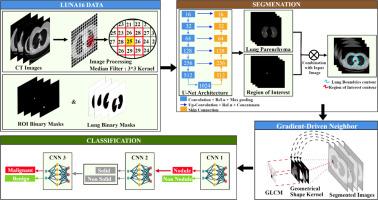Gradient-driven pixel connectivity convolutional neural networks classification based on U-Net lung nodule segmentation
IF 2.3
4区 医学
Q3 ENGINEERING, BIOMEDICAL
引用次数: 0
Abstract
Lung cancer is a significant global health issue, heavily burdening healthcare systems. Early detection is crucial for improving patient outcomes. This study proposes a diagnostic aid system for the early detection and classification of lung nodules from Computed Tomography images using deep learning, based on the LUNA16 Dataset. The methodology involves three key steps. Initially, a U-Net convolutional neural network is used for semantic segmentation, followed by features extraction and selection, which are subsequently used in classification with another convolutional neural network. The segmentation using the U-Net algorithm achieved an accuracy of 99.16 % and a Dice Similarity Coefficient of 88.44 %. For distinguishing between nodules and non-nodules in regions of interest, the classification accuracy was 90.36 %. Further classification achieved 91.89 % accuracy in differentiating solid and ground glass nodules and 91.54 % in distinguishing between benign and malignant ones. These results demonstrate the model's robust performance in categorizing various nodule characteristics. These findings highlight the potential of the proposed system as a valuable tool for clinicians, contributing to improved healthcare outcomes and advancing lung cancer diagnosis and treatment.

基于U-Net肺结节分割的梯度驱动像素连通性卷积神经网络分类
肺癌是一个重大的全球卫生问题,给卫生保健系统带来沉重负担。早期发现对改善患者预后至关重要。本研究提出了一种基于LUNA16数据集的基于深度学习的诊断辅助系统,用于从计算机断层扫描图像中早期发现和分类肺结节。该方法包括三个关键步骤。首先,使用U-Net卷积神经网络进行语义分割,然后进行特征提取和选择,然后使用另一个卷积神经网络进行分类。使用U-Net算法进行分割,准确率为99.16%,骰子相似系数为88.44%。对于感兴趣区域的结节和非结节的区分,分类准确率为90.36%。进一步分类对实性和磨砂玻璃结节的鉴别准确率为91.89%,良恶性的鉴别准确率为91.54%。这些结果证明了该模型在分类各种结节特征方面的鲁棒性。这些发现突出了该系统作为临床医生有价值的工具的潜力,有助于改善医疗保健结果和推进肺癌的诊断和治疗。
本文章由计算机程序翻译,如有差异,请以英文原文为准。
求助全文
约1分钟内获得全文
求助全文
来源期刊

Medical Engineering & Physics
工程技术-工程:生物医学
CiteScore
4.30
自引率
4.50%
发文量
172
审稿时长
3.0 months
期刊介绍:
Medical Engineering & Physics provides a forum for the publication of the latest developments in biomedical engineering, and reflects the essential multidisciplinary nature of the subject. The journal publishes in-depth critical reviews, scientific papers and technical notes. Our focus encompasses the application of the basic principles of physics and engineering to the development of medical devices and technology, with the ultimate aim of producing improvements in the quality of health care.Topics covered include biomechanics, biomaterials, mechanobiology, rehabilitation engineering, biomedical signal processing and medical device development. Medical Engineering & Physics aims to keep both engineers and clinicians abreast of the latest applications of technology to health care.
 求助内容:
求助内容: 应助结果提醒方式:
应助结果提醒方式:


